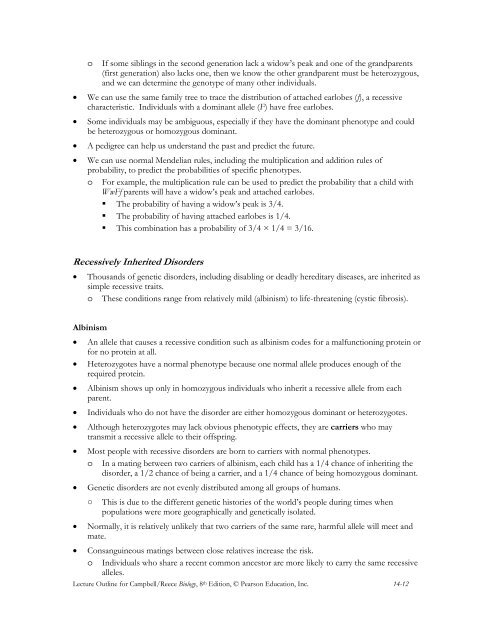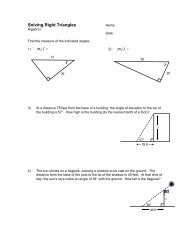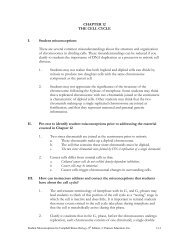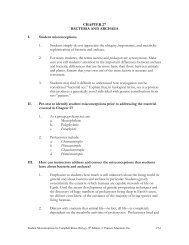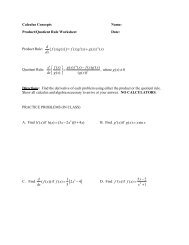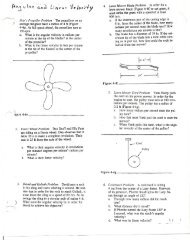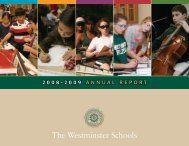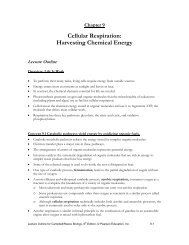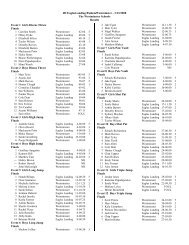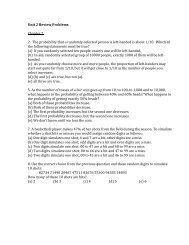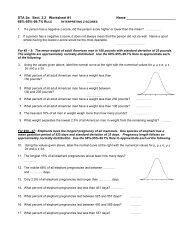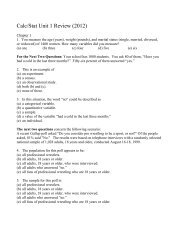CHAPTER 14 MENDEL AND THE GENE IDEA - Hancock High School
CHAPTER 14 MENDEL AND THE GENE IDEA - Hancock High School
CHAPTER 14 MENDEL AND THE GENE IDEA - Hancock High School
You also want an ePaper? Increase the reach of your titles
YUMPU automatically turns print PDFs into web optimized ePapers that Google loves.
o If some siblings in the second generation lack a widow’s peak and one of the grandparents<br />
(first generation) also lacks one, then we know the other grandparent must be heterozygous,<br />
and we can determine the genotype of many other individuals.<br />
We can use the same family tree to trace the distribution of attached earlobes (f), a recessive<br />
characteristic. Individuals with a dominant allele (F) have free earlobes.<br />
Some individuals may be ambiguous, especially if they have the dominant phenotype and could<br />
be heterozygous or homozygous dominant.<br />
A pedigree can help us understand the past and predict the future.<br />
We can use normal Mendelian rules, including the multiplication and addition rules of<br />
probability, to predict the probabilities of specific phenotypes.<br />
o For example, the multiplication rule can be used to predict the probability that a child with<br />
WwFf parents will have a widow’s peak and attached earlobes.<br />
• The probability of having a widow’s peak is 3/4.<br />
• The probability of having attached earlobes is 1/4.<br />
• This combination has a probability of 3/4 × 1/4 = 3/16.<br />
Recessively Inherited Disorders<br />
Thousands of genetic disorders, including disabling or deadly hereditary diseases, are inherited as<br />
simple recessive traits.<br />
o These conditions range from relatively mild (albinism) to life-threatening (cystic fibrosis).<br />
Albinism<br />
An allele that causes a recessive condition such as albinism codes for a malfunctioning protein or<br />
for no protein at all.<br />
Heterozygotes have a normal phenotype because one normal allele produces enough of the<br />
required protein.<br />
Albinism shows up only in homozygous individuals who inherit a recessive allele from each<br />
parent.<br />
Individuals who do not have the disorder are either homozygous dominant or heterozygotes.<br />
Although heterozygotes may lack obvious phenotypic effects, they are carriers who may<br />
transmit a recessive allele to their offspring.<br />
Most people with recessive disorders are born to carriers with normal phenotypes.<br />
o In a mating between two carriers of albinism, each child has a 1/4 chance of inheriting the<br />
disorder, a 1/2 chance of being a carrier, and a 1/4 chance of being homozygous dominant.<br />
Genetic disorders are not evenly distributed among all groups of humans.<br />
○ This is due to the different genetic histories of the world’s people during times when<br />
populations were more geographically and genetically isolated.<br />
Normally, it is relatively unlikely that two carriers of the same rare, harmful allele will meet and<br />
mate.<br />
Consanguineous matings between close relatives increase the risk.<br />
o Individuals who share a recent common ancestor are more likely to carry the same recessive<br />
alleles.<br />
Lecture Outline for Campbell/Reece Biology, 8 th Edition, © Pearson Education, Inc. <strong>14</strong>-12


